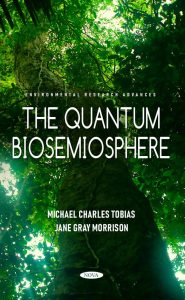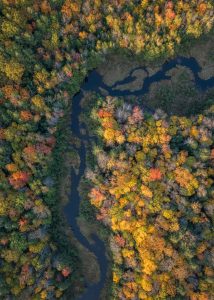An Entirely New Understanding of the Biosphere
Mar 9th, 2022 | By admin | Category: Other ResourcesBy Geoffrey Holland, writer for Transition Earth.
Let’s begin with a definition of the Biosemiosphere. It is a term most likely first coined by Susan Petrilli in an essay published in 2015, but most recently greatly expanded upon by Michael Charles Tobias and Jane Gray Morrison, authors of a new book from Nova Science publishers titled, The Quantum Biosemiosphere. It starts with biosemiotics, which refers to ‘the study of representation, meaning, sense, and the biological significance of codes and signs from genetic code sequences to intercellular signaling processes to animal display behavior to human semiotic artifacts such as language and abstract symbolic thought’.
The prologue of the new book by Tobias and Morrison states that ‘The Quantum Biosemiosphereimmerses the reader in the scientific, cultural and philosophical context and implications of human interaction with nature’. It is a transcendent way of being aware of and appreciating all the natural forces at work in our lives, seand also unseen. It reflects a waves and particles view of elementary life that requires a profound re-evaluation of the ephemerality and the abiding responsibilities to all other life forms of being human.
In order to appreciate the significance of the biosemiospheric perspective on life, as powerfully illuminated in this new book, we must first examine how humans have viewed their world since our first appearance as a distinct species something like 350,000 years ago. Our early existence is a well-known saga. It provides ackground context for the contemporary, and extraordinarily elegant eco-dynamic theories proposed by Tobias and Morrison.
For the initial 95% of existence, humans survived as hunter-gathers, with an unknown range of linguistic communicative skills. Stone-age humans were very much aware of the vast range of plants and animals with whom they shared existence. They saw themselves as part of a mystical weave that offered both opportunity and great peril on a daily basis. Survival favored those humans, who best employed their cognitive capacity to understand their reality; to use their knowledge to take advantage of opportunity and to avoid the risks that were part of life.
Agriculture and the Emergence of Cultural Repression
About 10,000 years ago, the majority of humans began to gravitate away from their nomadic existence to a life steeped in permanent settlements and dependence on agriculture. Up until that time, data acquired from thousands of archaeological sites suggest that humans made every effort to understand their surroundings; to be aware of every nuance and sensory clue coming from what Tobias and Morrison describe as nature’s “compound expressive potential.”
The need to protect a settlement’s ‘food stores’ from marauders gave rise to a male warrior class, and along with it a new way of looking at the world. Human culture was redefined by dominance and hierarchy, with men in charge, men making the rules, and women reduced to a form of chattel, subject to male authority. This story has been told in detail. Male dominance among humans has had massive consequences for the planet. Our destiny has been shaped by the assumption of human superiority over all over species; by the belief that humans are entitled, even obligated to exploit and consume the natural world, and that we can pursue that course without concern for consequence.
From the youngest age, human children have been taught to embrace the dominance paradigm and their place in the cultural hierarchy of human existence. Religious fealty was rigidly enforced. Women were particularly subject to violent repression.
Constant Growth and Anthropocentric Overreach
By 1970, the human population had reached nearly four billion. If measured by dominance alone, humans had become by far the most successful species on Earth. At the same time, the consequences of human or anthropocentric overreach had also become abundantly evident.
In just the past 50 years, the human population has doubled to nearly eight billion largely self-absorbed carnivorous marauders. Our geopolitical dysfunctionality undermines every conscious and unconscious biological measure – certainly at the vertebrate and invertebrate taxonomic levels – as described in remarkable detail by Tobias and Morrison. The species extinction numbers speak for themselves. Almost half of our Earth’s landscapes have been taken over by human agriculture and other extractive mechanisms. Humans and the livestock animals they raise to kill and eat now account for 96% of all the mammalian biomass on Earth, with just 4% of all the planet’s warm-blooded wild mammals still at large. At the heart of this current crisis, argue Tobias and Morrison, is the quintessence of cruelty, the largescale industrial exploitation of domesticated animals. What is needed is a new kind of conservation biology in which humanity endeavors to survive by fostering a communion with the entire range of lifeforms that comprise the biosemiosphere.
The world is connected as never before. People are sharing real time positive links on a global scale. At the same time, there are also a whole range of consequences that have gone with being broadly connected. All of humanity will be impacted if we fail to find a way to navigate and wisely manage a fully connected world.
*****
‘…biosemiotics is merely a word to connote untold mysteries, hopefully never denuded, that bind the living breath, blood, neurons, and dreams of forests, seas, rivers, and minds of every dimensionality into a functioning biologic perpetuity.’
~ The Quantum Biosemiosphere
*****
Embracing the Biosemiosphere
What The Quantum Biosemiosphere represents is a new way of seeing and appreciating the biosphere by recognizing with all of our hearts, sciences, technology and engineering that we humans are consequential newcomers with an inordinately vicious footprint. Tobias and Morrison urge us to ‘Imagine one trillion different subjective species circumstances, all working interdependently. That is the biosemiosphere we have not even begun to imagine.’
Biosemiospheric awareness opens up the entire spectrum of behaviors, signs, and communications within the broad range of plant and animal species on Earth.
Seeing nature biosemiospherically is not unlike many indigenous peoples’ clear-sighted predicates, though the extinction of languages and the exposure of ever more of the world’s remaining uncontacted peoples places this last true compass of wilderness in great peril.
Still, there is that share of our world’s contemporary humanity that remains utterly dependent on their natural habitats. In those cases, it is their choice to live openly and interdependently with nature. Such peoples, identified by Tobias and Morrison, embrace the complex connections within and among their biodiverse co-habitants; co-habitants that much of the rest of the world is only too eager to exterminate.
Humans that view their world through a biosemiospheric lens are well aware that life isn’t just about them. They view the natural world with gratitude. They embrace their responsibility to be faithful stewards of all ecosystems, both close and far.
Tobias and Morrison convey powerfully illustrative components of a quantum biosemiosphere that lays bare the miracles and enigmas of the profound science of interconnectivity. Their discussions of the mathematics, physics, art history, and anthropological co-efficients of the seen and unseen worlds is a unique challenge to the conventional simplicities of human hierarchical thinking and ethics. The Authors challenge us through empirical data and extraordinarily imaginative outreach, to recognize what may be our only chance of survival. Namely, the hallowing of Nature in all her miraculous parts, most of which we have yet to view, let alone understand. By this approach, and fully in tune with the latest advances in quantum physics, they propose a special theory of infinity, that is biospheric to the core.
We cannot grasp it, any more than great minds like those of Aristotle or the brilliant Buddhist Nagarjuna (c.150-c.250 CE) could do so. But today’s renaissance in molecular biology, genomics, de-extinction ideals and re-wilding aspirations, all converge on – at the very least – a new culture of gratitude to Nature that provides something of a roadmap for idealists around the world who are also practical environmentalists.
The unseen is celebrated in The Quantum Biosemiosphere. It forcefully includes an exponential awareness of the sub-cellular quantum reality in which infinite possibility exists in superposition. Every human observation adds meaningfully to the biocultural algorithms that translate into neural choices, reflexes, and ultimately surface level decisions about the future of life on earth, as viewed, made and re-made by humankind.
Tobias and Morrison ask, ‘Can biosemiotic advances and profoundly sensitive initiatives help ameliorate suffering? They follow with an answer. ‘The question rallies around a simple plan of action, that would seek to alter not the wild way of things, but humanity’s role within those biotic spaces.’
The time has come for humanity’s cavalier self-absorption to end. We are totally dependent upon nature’s complex living tapestry for our own survival. We need a new human narrative; one powered by our collective awareness of and gratitude for the full living complexity of the biosphere we all depend on. Tobias and Morrison’s The Quantum Biosemiosphere represents a groundbreaking work in that direction.
*****
‘As with any sense of duty that has been elevated in mind to a sacred responsibility, the personal visions of nature that guide our involvement in conservation are the beginning of every inspirational pivot towards heightened self-awareness.’
~ The Quantum Biosemiosphere
*****
Transcendence to Humanity 4.0
Clearly, humanity has reached its limit with archaic, systemic ecological overshoot. We have breached every geophysical planetary boundary. We must forge a new beginning, a new human nature shaped by a common commitment to responsible environmental and humanitarian stewardship.
The time for biosemiotic thinking has arrived. At its most basic, it is simply being aware of nature’s wondrous complexity, appreciating her, and being grateful for what we take from her, mindful that every physical constant demands that we give back.
Tobias and Morrison analyze the thermodynamics of the ecological condition. It is an entirely original way of thinking; a call upon all of us to comport ourselves in benign, compassionate ways, as spelled out in virtually every global ethical tradition. It needs to be reflected in every child’s upbringing and education.
We are in the sunset of post-modernism at this moment. It is toxic, deafening, and self-destructive. Biospheric survival hinges upon a revivified willingness on our one ungainly species’ part to begin anew, borrowing the best of our past, dismantling the worst, and muddling through to something that warrants the demands of evolution which, in turn, knows only an equal, not incoherent, biological playing field.
This newly called upon human era may or may not be emerging. There is demonstrable cause for alarm, fatalism, even nihilism. But there is also a fervent hope – shared by Tobias and Morrison – that humanity still has what it takes to enshrine a common commitment to dignity for all of humanity and a shared conviction regarding ecological humility, restraint, and unconditional love. That is the essence of thinking biosemiotically.
*****
‘People protect what they love.’ – Jacques Yves Cousteau, Planetary Explorer
*****
Geoffrey Holland is an award-winning Writer/Producer of long and short form video. He is also currently Coordinator of Dialogues for the Millennium Alliance for Humanity and the Biosphere.




